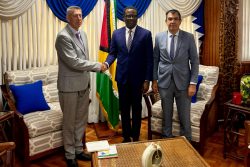Amongst our older generation, few topics (aside from the obvious political divide), can ignite a fire-storm of debate, like that of the Guyana National Service. Even the apolitical are apt to join in the heated discussion, which more often than not, seems to create two polarised groups of opinion – one strongly in favour of, and the other bitterly opposed, to the institution. Why does this issue, of a long-closed establishment, still produce such emotional wrangling?
This column has neither the space nor is it the appropriate forum to review the history of the Guyana National Service, but a synopsis is pertinent. Its origins actually were connected to the study conducted by UN Consultant Robert Landor in the mid-1960s for the then administration, on the subject of poverty and vocational training for the unemployed youth. Landor’s findings and recommendations, which were presented in February 1966, were accepted and adopted, leading to the formation of the National Youth Corps in January, 1968. Its objective was aimed at hinterland settling and agricultural development, an experiment which failed to come to fruition and was finally abandoned.
In October, 1973, then Prime Minister Forbes Burnham announced plans to introduce National Service, having previously hinted at it during the previous year’s Youth Week celebrations. According to an article in the Guyana Review in 2008, in December 1973, a State Paper introduced in the National Assembly, Burnham had stated that “the Service’s principal objectives were to ensure that all Guyanese within the formal training system were made aware of the new values of an independent society; to provide additional training, especially in the development of skills relevant to our development programme; to put emphasis on the practical approach in training and provide for the opportunity for on-the-job learning; and to accelerate the process of additional training, through National Service itself and also through existing institutions and new centres.”
The National Service was initially placed under the Office of the Prime Minister, and then later transferred to the Office of the President following the inauguration of the executive president in October 1980, cementing suspicions of political oversight. Millions of dollars were poured into the Guyana National Service, as the government sought to make it a success. Several training centres were created in the hinterland including, Kimbia on the Berbice River in 1974, Papaya in the Barima-Waini Region in 1975, and at Konawaruk on the Potaro River in 1976. A massive agriculture scheme was launched at Kimbia, where the cultivation of cotton, corn, legumes and other crops took place over 2,500 acres. Other ventures undertaken by the organisation included stone quarrying, goldmining, sawmilling and woodworking. These ambitious expansions and forays slowed down in the late 1970s, as the harsh economic times of the day forced the government to reduce the largesse required to upkeep the centres.
As consolidation took its toll, and with Burnham’s passing in August 1985, the National Service was placed on the back burner, leading to the closure and abandonment of the hinterland centres. By the time of the change of administration in 1992, National Service, no longer able to maintain its skills training initiative or sustain its agriculture programme, was in terminal decline. In 1994, the government shifted the training of pioneers from the flagship, Kimbia, the lone remaining hinterland centre, to Kuru-Kuru on the Soesdyke-Linden Highway. In 2000, the PPP/C Government officially laid the Guyana National Service to rest.
Burnham’s proclamation of the formation of the National Service had been received with much scepticism from the other political parties, some civic entities, and a significant strata of the society. The criticism ranged from its projected compulsory element, to its ideological orientation to the presumed military bias to the nature of training outlined. Its one-year fulfilment as a condition for University of Guyana graduates to receive their degrees, or for those awarded Government Scholarships to overseas universities, likewise, was not received with open arms.
In hindsight, which is always 20/20, perhaps Burnham’s plans might have genuinely commenced with the best intentions for the nation’s development and the occupation of the hinterland (re: the Venezuela threat/access to unoccupied territory) coupled with the shifting of the capital in the long-term inland (re: Brasilia) away from the omnipresent threat of being below sea level. Whether Burnham’s over-zealous approach to the project, the unilateral decisions adopted in its formation and implementation, the economic dictates of the epoch, its political slant or the military front it presented to the populace, led to its unwary acceptance and eventual failure, is a question for anthropologists and researchers to resolve. The fear it might have inculcated in some quarters of our society might justify claims that it contributed to the increased haemorrhaging of the brain drain.
Today it’s very easy to reflect 20-odd years after its demise and dismiss the concept as a waste of time and a complete failure. Was it really? How about the hundreds of pioneers (as the recruits were called) who might not have had the opportunity otherwise to attain skillsets and the accompanying self-esteem to build a life of self-reliance? In the same manner in which the project collapsed, who knows what heights it could have attained in the right economic climate, free of political interference.
While the topic of the Guyana National Service (1975 – 2000) will continue to provoke emotional exchanges amongst the older generation, the question we should be contemplating now is whether the service should be reintroduced sans the political slant, and with or without the military training as part of its curriculum. If so, should it be compulsory or voluntary? How long? Twelve months? Eighteen months?
It is important to note that this type of service to one’s country is considered a rite of passage into adulthood in many countries around the world. In Switzerland, for instance, all able-bodied males upon attainment of the age of majority are conscripted into the Swiss Army for two years of mandatory service, while women are allowed to volunteer if they wish to serve in any position. How much pride do the Swiss take in accepting this duty? A referendum in 2013 to abolish conscription was defeated as 73 per cent of the electorate voted to retain it.
At the present time, the suggestion of revitalising the Guyana National Service can perhaps be summarily dismissed as wishful thinking. It was the current administration that laid it to rest during a previous term in office, and even if not opposed to its return, based on their track record, one can safely assume that it would be heavily politicised (like everything else), in keeping with the trend of all the previous governments.
The continued absence of a platform whereby the younger generation is given an opportunity to simultaneously upgrade their skills and make a meaningful contribution to the development of our country can be only deemed a major national loss.







